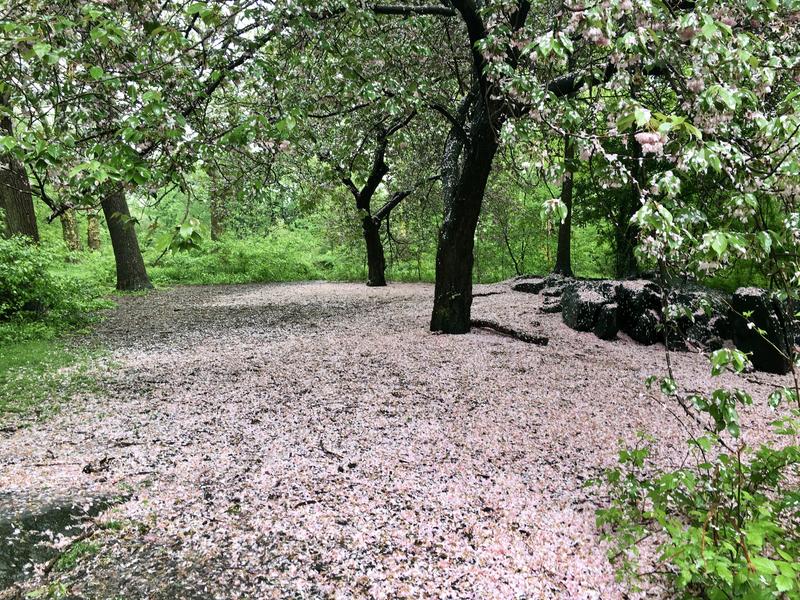Spring Trees in Bloom

( Kate Hinds )
[music]
Brian Lehrer: Brian Lehrer on WNYC. To wrap up a pretty heavy week in many ways, let's ask this, have you walked through a park lately? The trees are blossoming, and even in the drizzle and fog earlier this week, the city takes on a glow this time of year, doesn't it? It's like all the trees are practicing for Sunday's Easter Parade with all those fancy bonnets. Tell us, do you have a favorite tree in bloom, maybe in a special corner of your local park or on the street around the corner, or even in your backyard? Crabapple, magnolia, redbud, all bursting with blossoms? If you joined us last year for our #BLTrees series, you know my tree was the Callery pear, and it's also in bloom, beautiful white flowers right on my block.
We invited our companion for the #BLTrees series, botanist Marielle Anzelone, the founder of NYC Wildflower Week, to join us this morning, and we want to hear from you in these last few minutes. Share your flower and tree favorite or favorite spot to visit this time of year. If you need help identifying what kind of tree has caught your eye, probably, Marielle can help. 212-433-WNYC if you want to participate in this segment or ask a question about a flower and tree, 212-433-9692, or tweet, not like the birds in the trees, but @brianlehrer. Hi, Marielle, welcome back to the show.
Marielle Anzelone: Hi, Brian. It's good to be back. Thanks for having me.
Brian Lehrer: Do you have a favorite tree that flowers this time of year?
Marielle Anzelone: Oh my gosh. I have lots of favorites, and it's a little bit hard to choose, but in flower right this minute is a kind of magnolia, it's called saucer magnolias. I grew up in New Jersey and I would see these every spring, so it just really brings me back to my childhood. They're the ones that are-- They're in bloom now, the flowers are very large, and they're a gradation of a creamy white into a pink. They're very visible and they're beautiful.
Brian Lehrer: Yes, it seems to me as I walk around the city, it's like there are the pink ones and there are the white ones, but I don't think they're all the same, right?
Marielle Anzelone: Yes. Well, they're very different. In fact, it's a little bit complicated because some of them are species, some of them are cultivars. There's lots of different kinds of magnolias, and they do bloom at different times. We actually have a native magnolia, that Sweetbay magnolia, that grows in the wild, and that's not going to bloom for a little bit. Right now the ones that I have seen are the saucer and also the star magnolias, which have thinner leaves that look a little bit like stars, and they're typically only white.
Brian Lehrer: During our series, I don't think we talked specifically about tree blossoms, but we did talk about fruit. I know apple and cherry and pear trees have some of the prettiest blooms. Is there a connection between the flowering and the fruits?
Marielle Anzelone: Well, yes, because flowers are-- Some plants have flowers, and those flowers then all become fruits. The fruits that you mentioned are things that we typically think of as eating, that people eat, but anything that has a flower, the thing that happens later, some weeks later or months later, has a seed inside it, and it's a fruit, whether it's edible or not for people. That's botanical terminology. Of course, not all plants flower. Things that most people might recognize as not having flowers would be conifers and then other things like ferns, which, of course, are not trees.
Brian Lehrer: Let's take a phone call. Janet in Little Italy, you're on WNYC. Hi, Janet.
Janet: Hi, Brian. Yes, I live across the street from Old St. Patrick's Church, and the church has a cemetery dating back to the 19th century on both the southern side and the northern side of the church. The northern side is right across the street from me, and mind, it's a pretty narrow street. In the springtime, I always look forward to the timelapse show of these gigantic trees that the church maintains beautifully. They must be 90 feet tall.
As they start to bud, if I could do timelapse photography of, "Is there a green out there or is that like an acid flashback?" or "No, it's getting green," within like two and a half weeks, it goes from nothing to full green and it is breathtaking. They anchor the block there. We're all so grateful to the church for their care of those trees.
Brian Lehrer: So beautifully described, Janet. Thank you very much. Sharon in Queens, you're on WNYC. Hi, Sharon.
Sharon: Hi. My mom and her friend found each other by moving in the neighborhood across the street. They went to school in North Carolina early. Her friend across the street gave her a piece of crepe myrtle, a beautiful pink. They are both deceased, and I look at that tree and I have memories of my mom and her best friend and it makes me feel at peace.
Brian Lehrer: That's so beautiful, Sharon. That's one of the best tree stories we've ever gotten, even after 12 segments together, Marielle, last year.
Marielle Anzelone: Yes, that's really beautiful. Trees can be so meaningful, so that's just really lovely. What a wonderful story.
Brian Lehrer: Harry in the East Village, you're on WNYC. Hi, Harry.
Harry: Hi there. I am looking at a tree on my property on Eastern King Street, which my wife's mother gave us for a wedding present 40 years ago. It is beautiful white things, but it starts out pink. Soon all this pink will turn into white. It's a pleasure to look at.
Brian Lehrer: Harry, thank you very much. He's talking about a crabapple tree. Do some trees produce flowers that are one color and then produce flowers that are another color on the same tree?
Marielle Anzelone: Well, that could happen, but I think what he's talking about is actually the aging process of the petal. That's actually pretty common, where some trees will bloom white, and then as they age, will fade into a pinkish before the petals fall off. Of course, we love flowers with petals on them, but the petals are really just advertisement for pollinators to come and visit, and so they can be very flouncy, but they have a much shorter life cycle than the actual reproductive parts in the middle. They're there, and then once they've served their purpose and the flower is pollinated, they wither and fall off, and in that process, change color.
Brian Lehrer: Here's a tip for our listeners who are in New York City and want some advice as to where to look for flowering trees, the Parks Department puts out a tree map. Marielle, I noticed it's color-coded and you can pick out the flowering trees and go check those out. Have you seen that?
Marielle Anzelone: Yes, I have seen it. It's really neat. It's a wonderful way for people to be able to track places to go, but I'm a little old-fashioned about it. I just like to walk around. I think it's really nice to just go outside and just see what's going on. Even before the flowers come out, the earlier color, there's a lot to see. Even before the flowers fully come out, you can see the buds, and those are different colors too. It's a very exciting process.
Brian Lehrer: Richard on the Upper West Side has a favorite tree, don't you, Richard? Hi there.
Richard: I do. It's a cherry tree just at the entrance to Riverside Park at 91st Street. Every year for the last 5 or 10 years, a neighbor, I don't know which one, has put up a laminated copy of Housman's poem Loveliest of trees, the cherry now. Every year, I look forward to the bloom and reading the poem and I recite it out loud. This year, for some reason, the poem has not been posted. I feel like it's a loss.
Brian Lehrer: Richard, thank you for calling out the tree, though, 91st Street entrance to Riverside Drive. Eric in West Orange has a favorite tree, I think. Hi, Eric, you're on WNYC.
Eric: Oh, hi. Thanks so much for having me and taking my call. I have a tree in my neighbor's backyard that I see from my backyard that every year blooms a white, slightly pinkish flowers. It's not a very tall tree, but it's very broad. I don't know what it is, but every time I see it, it brings such joy. The coming of spring, it tells me spring is here, and I get to spend more time outside, and I just love it. Also, if I may, I have a question about a crabapple tree. I have a crabapple tree in my yard and it seems to flower every other year. I didn't know if that was unusual.
Brian Lehrer: Eric, I hope you're thanking your neighbor for their tree. Marielle, can you answer his question about the crabapple tree?
Marielle Anzelone: Yes. Every other year is a little unusual. Typically, they would flower-- Trees take a little bit of time to mature. Then once they begin to flower, so maybe it's planted and you have to wait 7 years, 10 years, but once they flower, they typically do flower every year. Every other year, I'm wondering if it could be a couple of different things. One is that some spring-blooming plants also flower in the fall because the temperature and light cues can be very comparable and it folds them into blooming early. Then you would lose the blooms for the following spring, or if there's some drought or environmental conditions where the tree is very stressed, and the buds are aborted before they actually open and bloom.
Brian Lehrer: We have about 30 seconds left. In Japan, going out to hang out under cherry blossoms is an activity in itself. There are festivals and picnics. I'm guessing you're all for making tree viewing an acceptable way to spend the day. Do you have any suggestions for where to see the most trees in bloom in one place in New York City?
Marielle Anzelone: Oh gosh, that's so hard. I think just for people to go out into your local park and just look around and be aware of what you're seeing. To see everything and bloom at once is maybe a little difficult, but almost every day something new is opening and blooming and it's just delightful.
Brian Lehrer: It's such a great time right now for exactly that. Thank you, Marielle Anzelone, urban botanist and ecologist and founder of NYC Wildflower Week, which is coming up next month. Talk to you soon.
[music]
Copyright © 2023 New York Public Radio. All rights reserved. Visit our website terms of use at www.wnyc.org for further information.
New York Public Radio transcripts are created on a rush deadline, often by contractors. This text may not be in its final form and may be updated or revised in the future. Accuracy and availability may vary. The authoritative record of New York Public Radio’s programming is the audio record.

